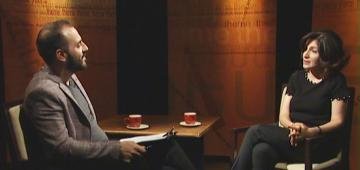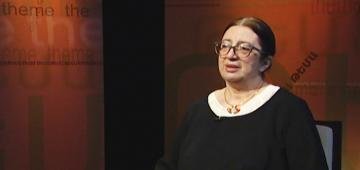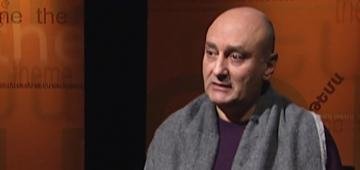 |
Artistic printing today2019 The Second International Art Printing Biennale will start in Yerevan on December 7 and will continue until December 15. During the Biennale, there will be exhibitions of Armenian and foreign artists, master classes. The Armenian art lover has the opportunity to follow the Polish, Chinese, German, French, Estonian-Armenian works created within the framework of this unique field of art. Hayk Hambardzumyan talked to Sona Harutyunyan, President of the "Cultural Dialogue" organization, about the purpose and achievements of the Biennale, as well as the problems of the development of art printing. |
 |
Conversation with Komitas in the language of colors and shapesA solo exhibition entitled "Komitas" by musician and artist Ani Hovak opened in Yerevan, dedicated to the 150th anniversary of Komitas. The young artist finds his Komitas with a combination of music, painting and sculpture, with a variety of perceptions of colors and shapes. Hayk Hambardzumyan talked to musician, painter Ani Hovak about the perceptions of Komitas' image and work, the significance and influence of his work. |
 |
Komitas in the lettersThe letters of Komitas are reliable sources for studying his image and work. They reveal Komitas' character, worldview, musical preferences. What stages of development did he go through as a composer, what influence did European classical music have on his work, what problems did Komitas face? Hayk Hambardzumyan talked about these issues with composer, pianist Arthur Avanesov.
|
 |
Komitas and 20th century musicWhat influence did Komitas's work have on the development of Armenian music in the 20th century? How well-known is Komitas' work in the world? Hayk Hambardzumyan talked about these issues with composer, pianist Arthur Avanesov.
|
 |
Hovhannes Tumanyan and the art of translating a fairy taleThe 10th International Conference on Fairy Tales was held in Yerevan, which this year was dedicated to the 150th anniversary of Hovhannes Tumanyan. "East-west. The goal of the conference entitled "The Art of Translating a Fairy Tale" by Hovhannes Tumanyan was the study of the peculiarities of Tumanyan, the translation fairy tale in general. Hayk Hambardzumyan talked to storyteller, translator Alvard Jivanyan about modern fairy tales, Armenian folk tales, as well as the charm and value of literary works.
|
 |
Narekatsi's new readingsThe Matenadaran hosted the 5th International Conference on Narekatsi Readings. How does the scientific conference contribute to the development of narcissism? On what principles do Armenian and foreign scholars approach the work of Grigor Narekatsi? Hayk Hambardzumyan talked about these issues with art critic Arusyak Tamrazyan.
|
 |
About the unknown pages of Komitas' life and workHow was Komitas in Etchmiadzin, Berlin and Constantinople? What musical reforms did he make and why? What new discoveries do Komitas studies provide today? Hayk Hambardzumyan talked to musicologist Lusine Sahakyan.
|
 |
The cause of the salvation of the Armenians in the Middle EastThe "Armenian Genocide Museum-Institute" hosted an international Conference and Exhibition entitled "The Case of the Salvation of Armenians in the Middle East in 1915-1923". How was the rescue of Armenian orphans organized in difficult times? What was the role of individuals and organizations? What was the fate of the rescued children and women? Hayk Hambardzumyan talked to AGMI Scientific Secretary Narine Margaryan.
|
 |
To Search for the ArmenianWhat are the deep issues related to the teaching of the Armenian language in universities or schools? What is the role of media, government and modern literature in the use and development of language? Where to start reforms and do you need them? Hayk Hambardzumyan talked about these issues with media researcher, poet Mariam Karapetyan.
|
 |
In anticipation of the Matevosyan CenterThe building of the "Hrant Matevosyan" Cultural Center-Museum has been built for a long time, but its opening has been delayed. Why is the operation of the cultural center delayed? What is the concept of the center, how can the work of such a center-museum affect our literary and cultural life? Hayk Hambardzumyan talked about these issues with the director of the "Hrant Matevosyan" Cultural Foundation, David Matosyan.
|
 |
Relevance of Art and The Art of RelevanceAfter a 12-year hiatus, Actual Art magazine was re-launched. What is the urgency, how relevant is the publication of such a magazine today, how does our society perceive the need for a new cultural discourse, critical thinking? Hayk Hambardzumyan talked about these issues with Davit Mosinyan, Candidate of Philosophy, member of the magazine's editorial staff.
|
 |
Soviet-Armenian poetry from the national awakening to trepidation. Silva KaputikyanSilva Kaputikyan's 100th birthday anniversary has been marked. What was the role of Soviet-Armenian poetry in the 1960s and 1980s in the national awakening? How did it accept independence? What was the reason for the development of Silva Kaputikyan's work, the fame of the poet? What makes Kaputikyan's poetry interesting today? Hayk Hambardzumyan talked about these issues with scientist candidate, associate professor Ashot Ter-Minasyan.
|
Topic
Author and host: HaykHambardzumyan
TOPIC hosts men of culture, clergymen, renowned filmmakers and actors, Armenian and foreign scientists, scholars of Armenian studies, young specialists, writers and journalists residing in and outside Armenia.
How much do the contemporary Armenian art and literature relate to the development trends of world art? What new Armenian studies are currently underway in Armenia and Diaspora? Does the modern art educate or it rather entertains? These and other questions are voiced and answered in the pavilion of TOPIC.
Frequency: Every Friday, at 21:50
Rerun: Saturday, at 13:30
